- What grasps look like in the major three categories
- Why some grasps are more advantageous than others
- What ages are typically developing children using these three types of grasp
Part 2. Factors Interfering With Pencil Grasp Development:Addressing The Root of the Problem
Today we will dive into
- What four main factors interfere with pencil grasp development.
- What parents and teachers can do to address those factors.
1. Hand Strength:
When a child doesn’t have the power they need in their hand to hold the utensil with their fingertips and apply necessary pressure for coloring or drawing, they will revert to whole hand-primitive grasps or static-transitional grasps. Sometimes lack of strength and endurance causes a child to fatigue and switch from using one hand to the other. Sometimes adults mistakenly believe this child has not established a true hand dominance, when the main factor is lack of strength and endurance.
Parents and Teachers can Help
There are countless everyday activities that children enjoy and can be encouraged to engage in to help facilitate improved hand strength.
- If you have a child who likes to build, then providing blocks that snap together and have resistance to being pulled apart is a great activity for building strength.
- If you have a child who likes to color, consider taking away all the markers and providing crayons instead.
- If you have a child who loves playing with water, give her squirt toys and bottles that she needs to squeeze in order to spray water. Putting soap inside the bottle might further encourage her to continue squirting to make more bubbles.
- If you have a child who likes to help with grown-up tasks, modify the task so that he can help but will still be working. For example, walk home from the grocery store giving him his own bag with handles to carry or have him stack cans in the cupboard one at a time.
- Use tongs or tweezers to hold another object, like holding a sponge to paint.
- Place clips on and off box lids or edges of containers.
- Use strawberry hullers to pick up small objects to sort by color, shape, or category.
- You may want to take a look at Print Path’s Blog post on using Tongs, Tweezers, and Clips or on Making your own Tweezers.
- Make confetti.
- Make ‘sequins’ for gluing projects.
- Punch out lines instead of cutting on them.
- Identify letters and letter sounds using puncher cards.
Pop beads, eye droppers, squeeze-activated toys and poppers are extremely motivating for kids to play with and are great for hand strength. Find even more ideas on Therapy Street For Kids.
2. Individual Finger Use ~ Dexterity ~
Fine Motor Coordination
- individual control of each finger.
- being able to move fingers independently of one another.
- being able to curl or keep stable the little finger side of the hand while moving the thumb, index finger, and middle finger.
- being able to move small objects in and out of the hand.
- being able to perceive the size, shape, & texture of objects and move them efficiently within the hand without looking.
We live in an age when parents and teachers are extremely cautious about children choking. We have taken away toys that contain have small objects until children are over three years old. There are negative consequences in relation to a child’s fine motor development when we do this. Consider what opportunities a three-year-old child has had to pick up and manipulate multiple small objects within his or her hands.
Parents and Teachers
Try using food for creative toys and art projects. Children can:
- string Cheerios to make an edible necklace.
- glue beans to give depth to coloring sheets.
- have children pick up a few rice puffs, and shift them one at a time onto a line of glue. *When the children are done, they can squish each rice puff into the glue with the tip of their index finger to make a textured art project. This activity will accomplish two objectives: working to build strength and to tolerate tactile input.
Specifically teach hand positions and movements for song participation. When you sing those songs, pause to let children assume and hold hand positions and make associated movements.
- Where is Thumbkin? — Where is thumbkin, here I am, here I am, how are you today sir, very well I thank you, run away, run away.
- Five Little Monkeys Jumping On The Bed — One fell off and bumped his head, mama called the doctor and the doctor said
- Five Enormous Dinosaurs Letting Out A Roar — One went away, and then there were four
- Way Up High In The Apple Tree — [Point up high] Five red apples smiled at me. [Hold up five fingers] I shook that tree as hard as I could, [Pretend to shake the tree with both hands] Down came an apple, [Wiggle fingers down from the air] Mmmm, it was good. [Rub tummy!] [Repeat with four, three, two, and one apple] smiled at me.
Using small objects for adult-supervised play:
- place small stickers to cover small dots.
- use the dominant hand to pick up disks, coins, or marbles one at a time. Using only one hand, move the object into the hand so that the little finger & ring finger trap it against the palm. Use the non-dominant hand to hold onto a container with a slotted top. Now using the dominant hand, move the small objects one at a time to the finger and thumb tips and place it into the slot.
- string beads while holding two or more small beads in the hand.
- learn to button or engage a zipper.
- with a blindfold on, try to sort quarters into one dish and pennies into another.
3. Tactile Sensitivity
Sensory aversion in the realm of touch is a common factor interfering with the establishment of a functional pencil grasp. Children with these types of sensory issues can often be seen holding a pencil or crayon high on the shaft and with their hand off the table surface. This is a typical way to hold a writing tool at 2 or 3 years old. However, as children matures, if they are uncomfortable with their hand and arms touching the unpredictable textures and temperatures of papers, tables, and art materials, their pencil grasps may not progress to functional grasps. When a child holds a pencil with any of the primitive grasp, he or she are moving from the shoulder. Because shoulder musculature is larger, it is less precise. As the child matures, the locus of control moves down the arm, and the child gains more precision with movement. When you see movement that generates from the fingers, that is fine motor movement.
Original illustrations by Kate Hadfield Designs
This is a simple progression from least tactilely challenging to most challenging. These activities will not work to help children accommodate to tactile challenges if they are in distress. Teachers & parents must do whatever is possible to make the activities fun, enjoyable, exciting, and special. Distract the child from the “yuckiness” with playfulness and fun drama. Then gently extend the play the next time. Kids generally need to be comfortable and self-initiating one set of activities before they are able to move on to the next. If you are a teacher and your classroom is doing a shaving cream activity, it is OK to accommodate the task for a sensitive child to avoid their becoming distressed. You can let the child wear gloves or use a paint brush instead of fingers.
- Scooping, hiding, and finding objects hidden in tubs of dry beans/rice/sand.
- Getting and placing stickers.
- Gluing small snips of paper or objects, first with a glue stick and then with bottle glue. At first, using glue may be a huge issue. After a child
- Squishing, squeezing, forming, rolling, and pulling Play-doh and then more sticky recipes for goop.
- Tracing, piling, scraping, smearing, and rubbing shaving cream.
The preceding list is a sequential outline best suited for day care or classrooms. If you are a parent, go ahead and use any of those ideas, but you have two other mediums that are already part of your everyday routines that you can use to decrease tactile aversion. A word of caution: IF YOU THE PARENT HAVE TACTILE AVERSION ISSUES, it is natural for your child to learn these from you. Either you will need to turn them off [not show them to your child] or get another parent of family member to help. What are the two powerful mediums?
- Food preparation. Start with letting your child ‘help’ make her favorite foods and pour her favorite drinks. This of course means more work for you! You can progress to ordinary everyday food prep and then to making special baking treats.
- Bath time. Bubbles, soap, water colors, bath paints, shaving cream, washcloths, or wet tub puppets are all easy to explore and play with in the tub, before or during a bath and can go a long way toward decreasing tactile aversions.
If the child you are concerned about uses writing tools with hands and arms off the table, then check their comfort level on this continuum. Even after they have mastered these sensory inputs, if they have had a history of tactile aversion, you may see them still lift their writing hand off the table. In this instance, it is a motor habit and you can bring it to their attention. You can show them how to put their hands on the table. Set up a touch or visual cue to remind them. The next you see them forgetting to put their hands on the table, you can gently remind them with a touch or picture cue and not have to say anything. An excellent resource for parents whose children have a variety of sensory issues: The Out-of-Sync Child Has Fun: Activities for Kids with Sensory Processing Disorder by Carol Kranowitz
4. Hand Dominance and
Crossing the Midline
Many children seem to express a strong hand dominance even at six months old. But others take a few years to develop a specialized side. If the child you are concerned about has not established a clear dominance for writing/drawing/coloring, the maturity of their pencil grasp may lag. Children with delayed or disordered language development show significantly less establishment of left- or right-hand preference (Escalante-Mead, Minshew, and Sweeney: 2003). Both lack of hand dominance and delayed speech are thought to be due to decreased specialization in the hemispheres of the brain. My personal observation after 25 years of clinical work with children is that ease of hands crossing the center of the body correlates with establishing hand dominance. Ease in crossing midline may be due to the degree of specialization in the hemispheres of the cerebral cortex, but researchers have not yet asked or answered this question.
Approach when hand dominance is not clearly established:
Part 3. will identify
- What tips and tricks OTs use to support the highest level grip a child is able to use.
- When pencil grippers should be used.

Check out these products supporting pencil grasp development:
|
|
|
|
[inlinkz_linkup id=678932 mode=1]

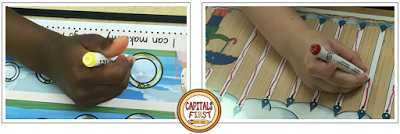
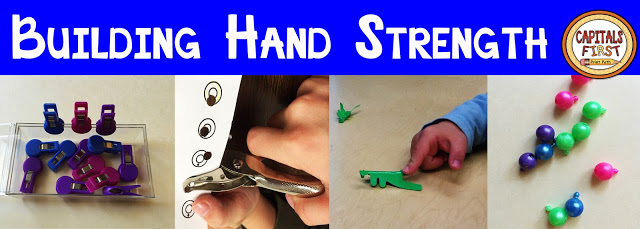
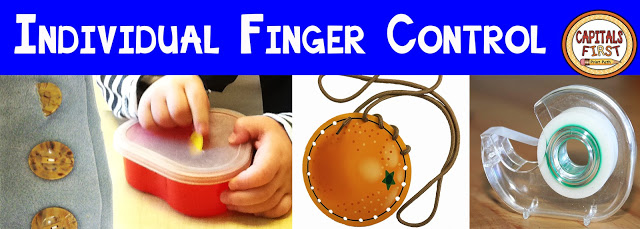

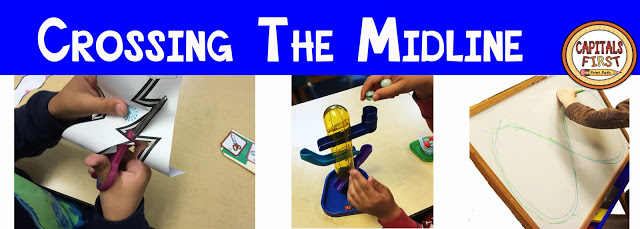
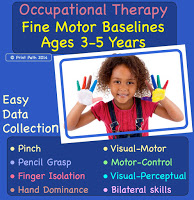
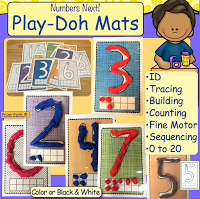
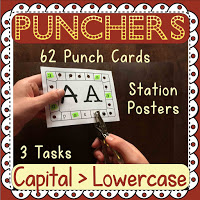
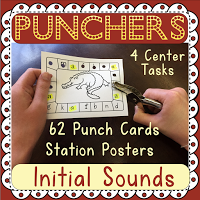
This is great! I have never considered that tactile sensitivity might be a reason why my student’s struggle with pencil grip. Some great ideas here!
Yes, tactile is a very frequent interfering factor with many of the SPED kids I work with! Luckily, once you know what is going on, it is not a hard one to fix.
This article was so informative. I have worked with OTs for many years, and sat through many meetings and did not hear much of this.
My pleasure, and I am glad that you found this post informative! Thanks for stopping by.
There is so much helpful, useful information about gross and fine motor skills on this post. I have been in special education for a long time and learned a lot by reading this post. Thank you for sharing this, as well as the links for activities.
Play-Doh is one of my favorite activities. I love the feel of fresh Paly-Doh.